
National service started for me in November 1952 at the age of 18 plus. In the previous year I had passed my driving test first time on a Morris series 'E' in Chichester well before their famous clock tower alterations. Lessons were 15/- (75p) an hour (In Jan09 value would be £17.88), and shortly afterwards I took my full motorcycle test on a power assisted bike - my old Raleigh cycle fitted with a PowerPak 49cc 2str engine (£22.15s.0. fitted - and who needs brakes! (£542 in Jan09)) - this incidentally entitled me, in theory, to ride a 1,000cc Vincent 'Black Shadow' without "L" plates!
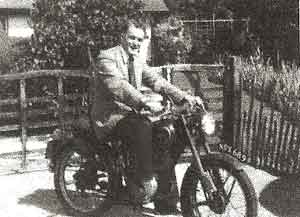
My first 197cc James. (Thanks to Peter Rose.)
My car driving was restricted to my mother's Standard 8 tourer with Bendix brakes which just would not stop the car rolling backwards when stopped on a hill! - A terrifying fault which still occasionally gives me a disturbing dream at night. As far as bikes go I had the aforementioned Raleigh, a James 197cc, and a Corgi folding motor cycle. Crash hats were not generally available and possibly considered slightly sissyish, but there wasn't all that much traffic about then............
I had just finished an electrical diploma course at Brighton Technical College when, almost immediately, I had a letter telling me to report for a conscription viability test in Brighton, so along I went in trepidation on the due date.
The medical was somewhat intrusive but they seemed happy with me, I appeared to have done quite well in the initial test too and it was my first attempt at a multiple choice exam. Despite having an "R" as a first letter surname I was surprised to be called out first and had an interview with a very laid back squadron leader wearing a very bright, non regulation, yellow jumper who talked me into signing on for a three year stint instead of the compulsory two - I suppose it was the lure of the extra money - 11/- a day (£11.36 in Jan09) against the normal 7/- (£7.23 in Jan09) (an extra 20p a day (£1.72 in Jan09)).
My actual call up came shortly afterwards but before I left home I'd asked a friend, John, for any advice and he'd told me to take my own sink plug, and so equipped a couple of weeks later, I bid a tearful (she didn't see) farewell to my mum and with my new rail pass took the train to Victoria and then on to Euston where military rail transit shepherded us onto a train to RAF Cardington. I had never felt so alone but there is always someone in the same boat and very soon a rapport was struck up.
The following day came the inevitable short back and sides haircut - the "barbers" seemed to take delight in cutting (shaving) exactly half the head first and showing the result in the mirror - I remember vividly one gypsy type with long flowing locks crying with frustration. The issue of personal service numbers came next but again, because I had done a few weeks ATC training at the Grammar School in Maidstone where we were then living (it was that or gardening) I had a different number than the others and was called out first to, I suppose, show them how to stand to attention etc. Kit was issued next but as there was a shortage of full webbing all of us had to make do (fortunately) with just a webbing belt. This situation continued for all my time in the RAF and saved an awful lot of blanco'ing over the three years. Some of the older NCOs were still wearing the original 'forage' caps but we were issued with the new style regulation 'berets' which when not being actually worn on the head, were neatly folded into the uniform shoulder epaulette.
Civilian gear (the stuff you wore on arrival) had to be sent back home by rail with a note for the parents to collect the package from the local station on payment of 1/- (£1.03 in Jan09). After more checks I was posted to RAF Hednesford in Staffordshire as an Aircraftsman grade 2 (AC2) to complete the compulsory eight week square bashing introduction course. It was the lowest level of privation I had experienced, the weather had clamped down for winter, up at unearthly hours, drill, PT, and discipline, discipline and more discipline.
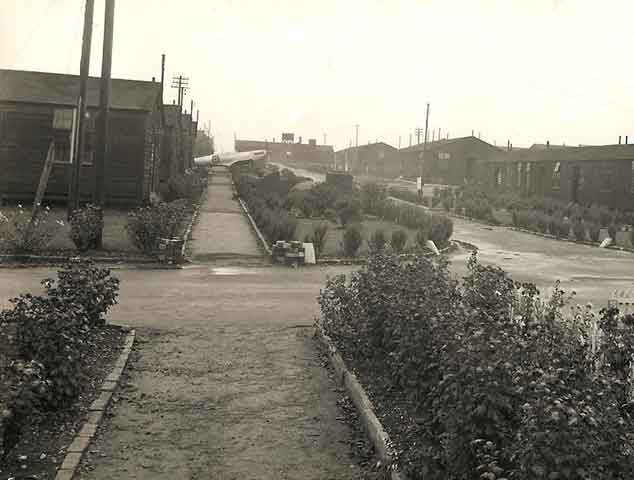
RAF Hednesford the Hutted lines outside- Nov/Dec52. (Thanks to Peter Rose.)
In hindsight, I have never been so fit and it really made me appreciate the luxury of simple things which I had always taken for granted. If you had one, it was possible to leave a 10/- note (£10.33 in Jan09) on your bed and it would be still be there when you returned. I learnt to darn socks, sew on buttons, and do simple ironing. We of course had no iron on arrival, but the corporal in charge (GOD) happened to have a couple left from the previous intake, so we had those. There were no power points in the billet, just interior lights hanging down on flex from the ceiling; but with careful fitting of an adaptor and the strengthening of the 5 amp fuse, the two irons could be made to do their job. Thank goodness the hut never caught fire whilst we were there. No Health and Safety issues in force in those days.
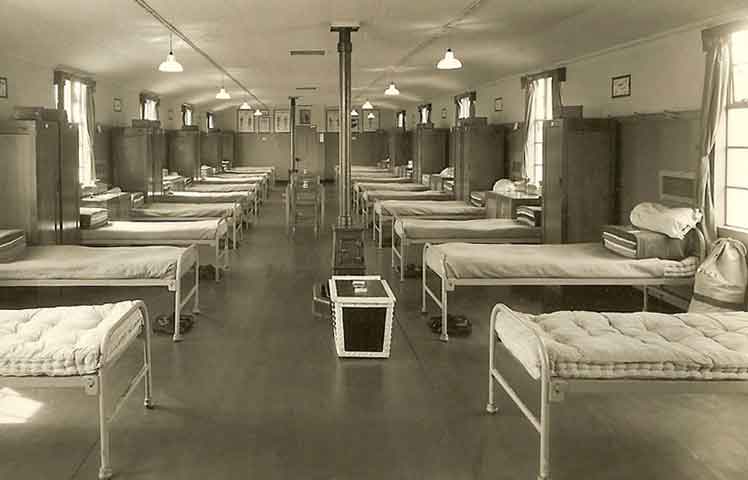
RAF Hednesford inside the Huts- Nov/Dec52. (Thanks to Peter Rose.)
Never ever have a bed with the stove at its foot - everybody comes and sits on your bed all evening and the stove would go out in the cold hours of the night leaving you far from warm. But I never fully understood why, if one was sick, one had to get up even earlier, wash, dress, and report for sick parade, well before the rest were even having their breakfast - sickness was not recommended, I suppose. In those days sex was a subject not discussed except in somewhat giggling, naive terms and this was not helped by having been shown a series of rather disturbing, vivid technicolour films about the perils of trying to find out more. I'm sure a lot of us had really not much idea of that side of life and the RAF liked it that way - there was even talk of bromide in the tea.
One of our unit airmen was a very good sportsman and on discovery of this, the powers that be took him away very quickly, and he appeared for the rest of his National Service playing for the Royal Air Force, either as a rugby football winger in winter, or a cricketer in the summer. We never saw him again and were envious of his apparent escape of 'bull'.
We were taught to shoot old Lee Enfield first world war rifles and to keep them clean, how to dissemble and reassemble the Bren gun, and finally to use them on the range. I was useless with guns and was the only one to score a complete washout with the Bren in the fully automatic firing mode. Each to his own. Anyway I must have passed this training programme as I was made up to an AC1 (aircraftsman grade 1) and advised of a posting to RAF Yatesbury in Wiltshire.
Seven days leave came next which was bliss and I found I was quite proud to be wearing my uniform; at least to go home in that is. So on to Yatesbury on a 14 week course to become an Air Radar mechanic. It was so laid back after the square bashing (no jumping to attention every time a corporal or higher rank spoke). It was a long but interesting course and we dealt solely with the radar set fitted to the Gloster Meteor aircraft which, rather conveniently for me, were stationed at RAF Tangmere only 10 miles from my home. We had all sorts at the camp, one chap even had full evening dress hanging in his locker and an MG sports car in the car park, others had virtually only the clothes they stood up in. We even had two chaps who were married but were still able to send money home from the paltry amount they received. I learnt to cut hair and found the ginger haired people easier to do and the black haired ones the hardest.
I was able to get home regularly during this time using the camp shuttle bus to Portsmouth and then train home to Bognor Regis, where we had then moved. I can recommend these Bedford OB buses - they most certainly can shift with a spirited driver. I did try and use my motorbike once but it broke down and a friend and I had to hitch back to camp, we were late and we both had two days "jankers". I pleaded for my friend but to no avail - the lack of webbing helped us on this punishment as there was so little to clean!
Hangar guard duties were done on a rota system which meant that every now and again you would "patrol" the airfield in the early hours armed with an unloaded rifle looking for spies. It usually involved sitting in the cockpit of a grounded and mainly gutted, wartime bomber, shivering, waiting for your duty to finish. Again, one does appreciate life's little luxuries at these times. I learnt how to take the radar set apart, to solder, to rewire, and finally I passed the exam to become a fully fledged Leading Aircraftsman (LAC).
Again, a short visit home and then a posting to a transit camp, RAF Lytham St Annes to await a further posting abroad. I had requested a home posting as my mum was then living on her own and my only brother was away in the Royal Navy. The organisation, SSAFA, went to see her but apparently couldn't agree that I have this compassionate posting so I had to wait again for the new posting but there was time to visit Blackpool and the sights (three of us in uniform even dated three local girls in the Tower Ballroom but ran off whilst they were in the Ladies!) - who says chivalry's dead?
I had originally applied for a home posting but was eventually sent to join 2nd TAF in Germany. Some who had applied for a German posting were sent to the Far East so I can only think that I should have applied for the Far East and then probably would have been sent to RAF Tangmere near home and my mum.
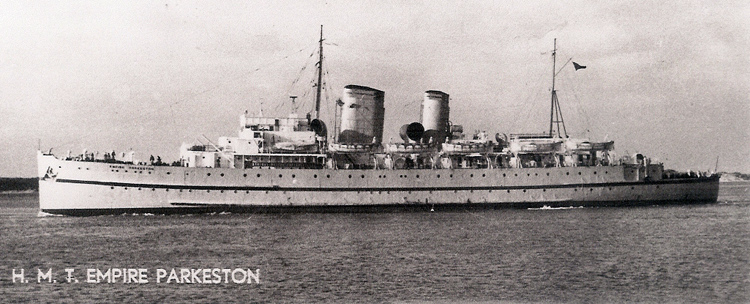
The 'Empire Parkestone' sister ship of the 'Empire Wansbeck' which plied nightly between Harwich and the Hook of Holland, taking all ranks of all three services, and support civilians, to and from their postings in BAOR. (Thanks Ken Senar)
The trip to Germany was by boat to the Hook of Holland from Harwich, via the military north sea ferry service. These specially adapted ferry boats had large accommodation holds where we slept in high tiered bunks but as it was only for one night this was acceptable. The secret was to get to bed as soon as possible before the sea had a chance to get rough.
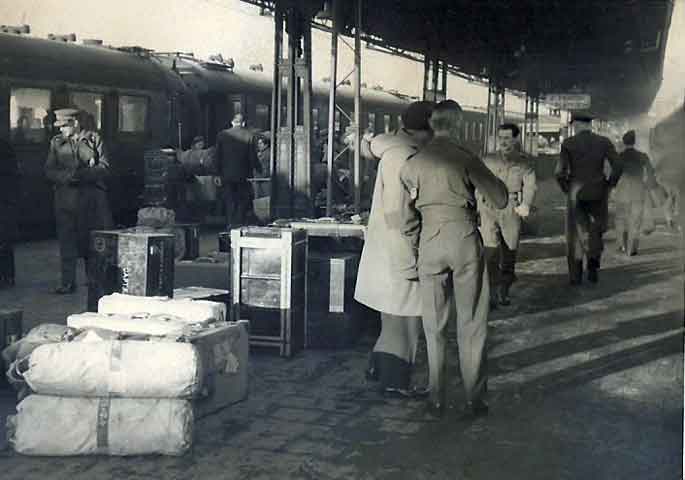
Early morning busy platform at The Hook of Holland where those returning from leave at home changed from the ferry to the railway for the final leg back to Jever. Probably early 1953. (Thanks to Norman Giffin.)
We were treated very well on the continental part of the journey to and from camp in the military transit trains coded red, green and blue. A meal was served on the way and the trains passed by the huge Phillips factories in Eindhoven en route - mile after mile of brilliantly lit warehouses and offices.
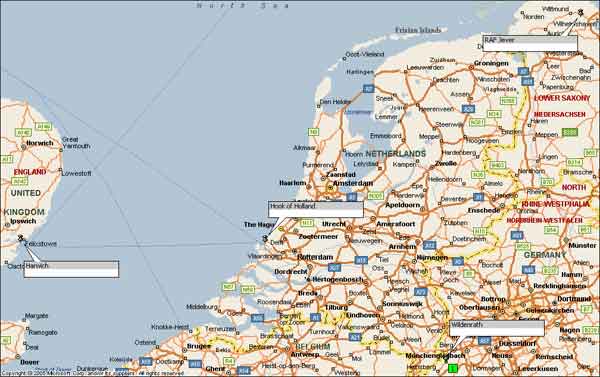
Map showing location of Harwich, Hook of Holland, Wildenrath, Dusseldorf and RAF Jever. (Thanks to Microsoft Autoroute.)
The correct train eventually dropped us off at a staging post and a small party of us taken by truck to the RAF camp at Wildenrath, close to Dutch border, where we were to be attached to the Sabre Conversion Unit.
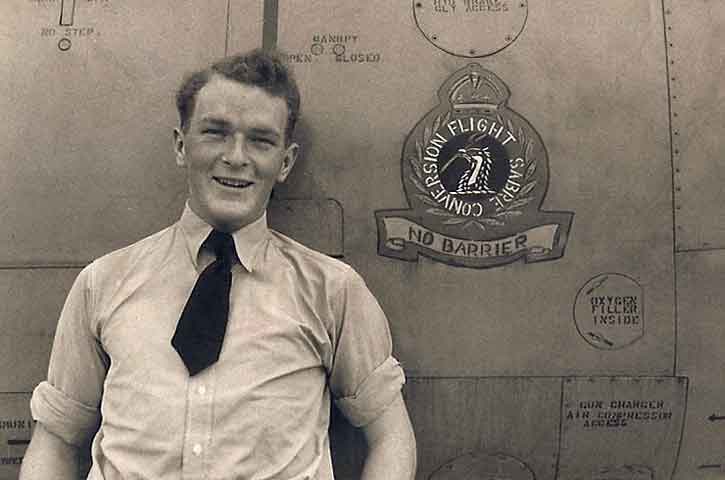
Peter Rose next to the Unit Badge for the Sabre Conversion Unit at Wildenrath - about 1953. (Thanks to Peter Rose.)
Once settled in at Wildenrath and only having the regulation issued kitbag, all of us then started to have civvies and assorted clutter to carry around, so one of the first ports of call was to Wildenrath town for a large but non-expensive suitcase to take all this extra gear. We were well catered for in the local luggage shop as it was a problem for everybody and the shop obviously did good business with service personnel.
The billets were beautifully arranged in amongst conifer trees at the station and were all single storey chalet type. Huge lagged, insulated and above ground pipes snaked across the ground, billet to billet, carrying hot water etc, the insulation was worn right through to the actual pipe itself when crossing a short cut used to and from the mess or NAAFI. In the winter it was so cold a tin mug of hot tea would be frozen solid by the time you got back to your billet. At our young age this walk was usually done in shirt sleeves too!
The commanding officer was a wartime fighter ace, Group Captain Johnny Johnson whom we all idolized. He also didn't seem to be all that keen on too much 'bull' which went down well with us lads. There were two oldish DH Vampire Venom twin seat jets stationed here and we all had the opportunity to sample a flight in a jet aircraft but I found I was not made of the sterner stuff that fighter pilots are!
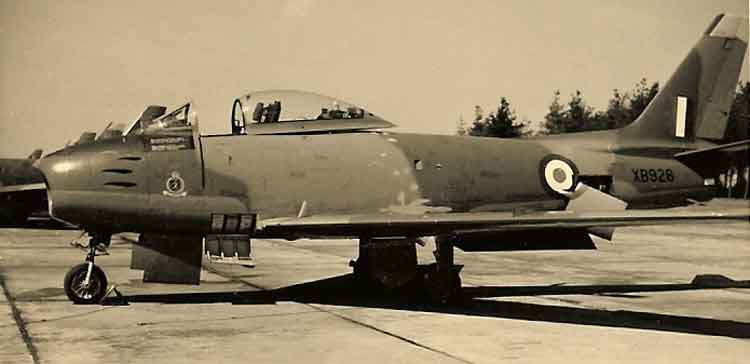
Sabre F.4 XB926 from Sabre Conversion Unit at Wildenwrath - Apr/May54. (Thanks to Tony Pearce.)
Unfortunately for me the Canadair Sabre jets were not fitted with radar so I was on general duties until one day when we were all asked whether any of us could drive. I was the only one who had a licence and the MT sergeant arranged for me to have a test on a Bedford QL 4x4. This was a far bigger vehicle than I had ever driven but I obviously didn't do too badly because I passed their test and went on to drive one on the various exercises that were carried out for the squadron.
The squadron went to an old deserted wartime airfield in Belgium on one occasion and we had to take a vast mobile kitchen unit there towed behind a large Scammel tractor unit which did not like one steep hill with the result that masses of full 5 gallon jerricans had to be unloaded from the rear of this tractor and carried up by hand before the unit could move; but as a driver I was excused this portage. Camp was set up in a remote part of the airfield and included an outside, open to the elements, crude loo with simple cross bar and it was not surprising how little this was used as we all quickly discovered that one could go a long, long time without paying a visit. We all had plain canvas tents but the officers had theirs with electricity which I helped install. We were well received in the Belgian pubs which was a pleasant change from the more subdued reception we were used to back at the town near Wildenrath but this was only to be expected.
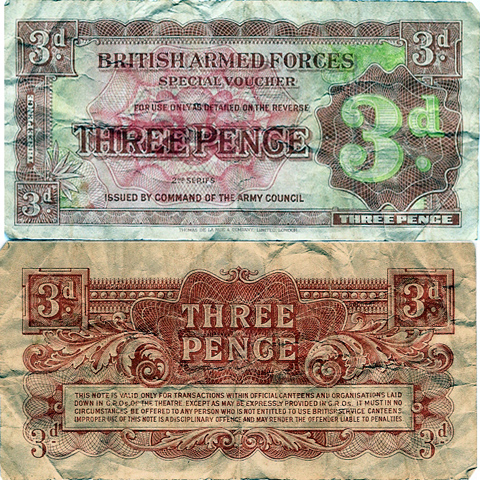
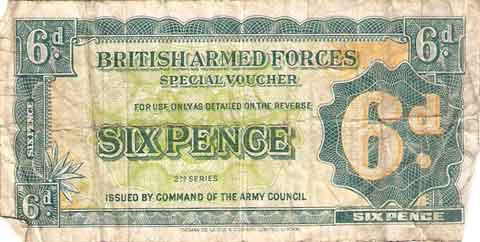
Our Main Currency - The BAF - before the DM. (Thanks to Gladys Watson and Ken Bibby)
It really wasn't necessary to go out from the base anyway as there was a NAAFI and a Malcolm club which catered for most needs. We were paid in military paper money called BAFVs and the notes ranged from 3d (1p) (26p in Jan09) up to £1 (£20.65 in Jan09); If we wanted German money these BAFs were exchanged for Dmarks (at 12 for £1-0-6d (DM11.70 to the £) then (£21.17 in Jan09)) after the weekly pay parade. This high exchange rate made local goods such as watches and 35mm roll film cameras very affordable. The squadron also visited Wunstorf right on the East German border which was used for the Berlin airlift operation a few years previously. It was now occupied by the American air force and we really appreciated the much higher quality and quantity of food from their PX at meal times. 'YOU GUYS LIKE ANY MORE?' - unbelievable.
I was later asked to show other people how the QL's drove, simple servicing etc. The pilots had no difficulty in mastering the controls, but I suppose if you can fly a jet, a simple four wheeled vehicle must be a doddle, although one chap did get us up onto two wheels around one corner - there is not much the passenger can do so far away on the other side. These QL's were a very smooth drive, very flexible albeit a bit noisy. They would only start by handle when cold, but on the button when hot. The RAF versions were not fitted with any form of indicators but had a crude red and white striped board which slid out from either side of the vehicle at cab roof height when so pushed by the driver from above and behind his head. I also had the obligatory rear triangular sign "Achtung Farhschule" hanging off the tailboard. It was a pleasure to drive out of camp, be your own boss, and circumnavigate a nearby road called the Wegburg Ring, both clockwise and anticlockwise.
Munchen Gladbach was the nearest town, with Dusseldorf the city we would visit on the occasional weekend, and it was surprising for us to see the office lights still blazing late-on Saturday evenings as the locals worked on whilst we were at play.
One thing I did learn at a rare squadron get-together in the hanger was in watching our unit C.O. care for his drink! He had a pint tankard of German beer held by its handle, right down by his knee, out of harm's way, where he was able to be jostled by the crowd and never spill a drop. I have tried this and it really does work. No good with an ordinary glass - must be a jug with a handle.

93 Squadron Sabre F.4s lined up in front of Hangar 3 - May54?. The nearest Sabre looks like T-C which is airframe number XB746 that arrived on the Squadron on Thu 8 Apr 1954 and left Cat 4 on Wed 10 Aug 1955. (Thanks to Bryan Lee.)
The Sabre conversion squadron came to an end eventually and we were all dispersed to other bases throughout northern Germany. I ended up at RAF Jever near Wilhelmshaven, on the north German coast, with No 93 fighter squadron, again with Sabre jets.
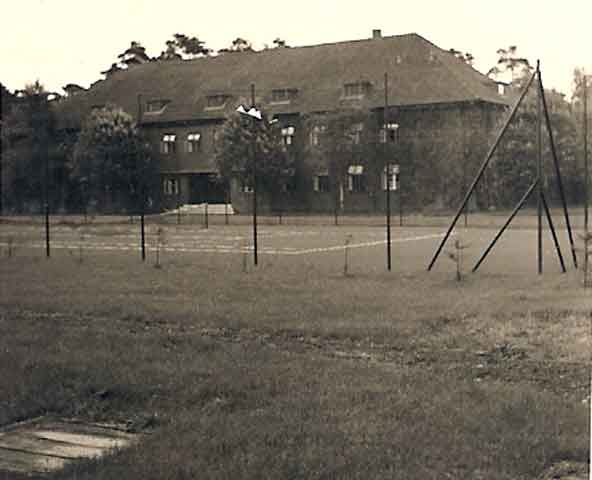
93 Sqn Barrack Block - Early 53. (Thanks to Lofty Hope.)
The billets at Jever were all very well constructed and had, I now understand, been built as an old peoples home just before the 1930's as this was allowed under the restrictions placed on the nation after the first world war. This was a ruse as the German forces used them during the second world war but we now had them for our use. Three storey blocks of solid buildings with the lower storeys used for accommodation. The roof space above was vast enough to be used for table tennis, music practice etc., and there was even one smaller room there with a large pin-up selection. Where the pictures came from I have no idea but there was a delightful choice of what to gaze at.
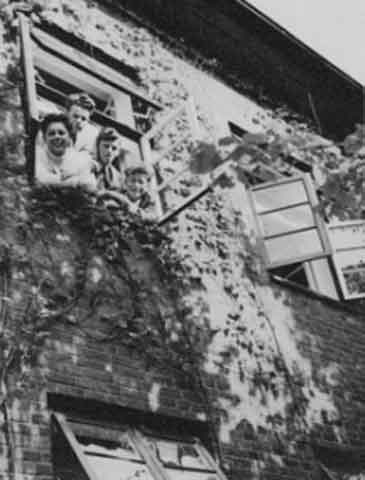
93 Sqn Barrack Block - L to R: Freddie Briscoe, Scottie, Bob and Tony Hutley
(Thanks to Tony Hutley.)
The individual accommodation rooms all had a simple sort of double glazing comprising one set of windows on the outside, a 6 inch gap, and then a second set of windows on the inside. It was possible to get draught proof ventilation at night by having one outer window open at one end and one inner window at the other end. I can't remember whether they were opening or sliding windows but I most certainly do remember they were the very devil to clean for inspections days.
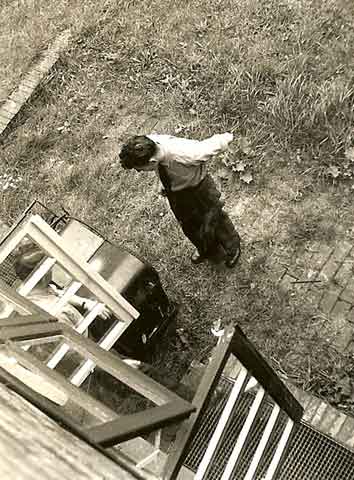
Spraying a locker in preparation for C-in-C's visit - Sep55. (Thanks to Peter Rose.)
At the CinC's inspection it was decided by the powers to be, that we would respray all the individual lockers green. To this end every locker was emptied, taken outside on to the grass and repainted using the station compressor/sprayer. This process unfortunately left outlines of differing green on the grass so it was decided, again from up high, to respray the whole grassy area for his visit. Did he notice I wonder. I liken this to having to cut the grass at square bashing with scissors.
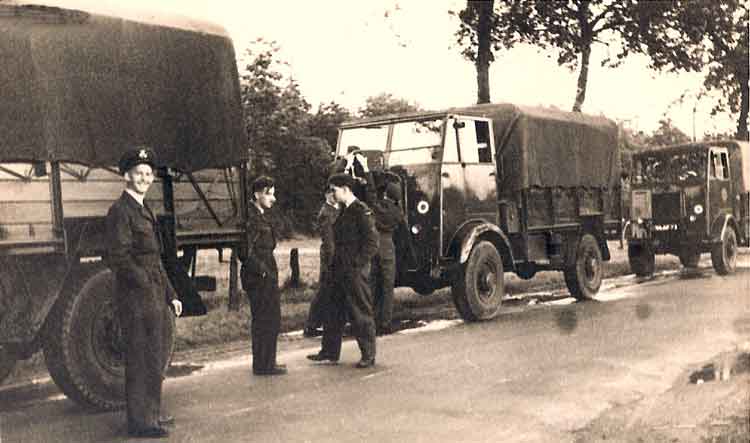
Thorneycroft convoy. (Thanks to Peter Rose.)
There were no Bedford Qls at Jever, only the equally old, tried, and tested Thorneycroft 'Nubians' which had a big 4 cyl engine that revved much more slowly. I drove one of these trucks every work day from the billets, with the ground crew in the back, over to the other side of the aerodrome where the squadron hanger was. Here we had the use of a four wheeled canvas sided trailer which was our crew quarters during the day where we spent time waiting for the next job to arrive.
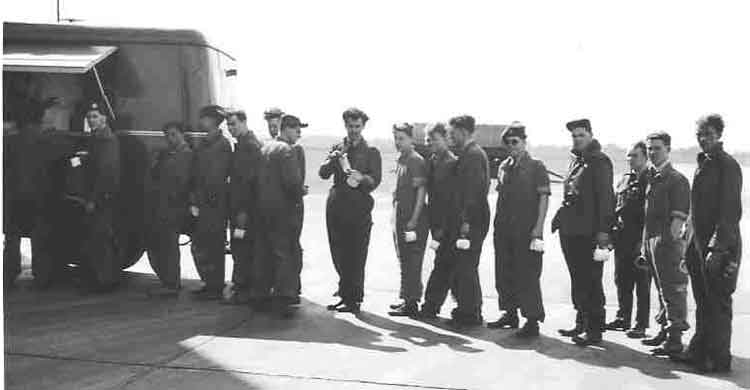
Groundcrew Tea Break. (Thanks to Bill Sutherland.)
A NAAFI truck would arrive during the morning and afternoons, and long queues form as we all waited to be served with tea and a bun. Please do remember in those days sweets were still on ration and the humble banana unheard of.
Cigarettes in Germany were only 20 for 1/- (5p) (£1.03 in Jan09) so it was not surprising most people smoked and this was allowed in the trailer. I tried a pipe for a time but found them a bit messy, always going out, and they made my index finger charred with all the tamping down. There was one chap in our room at Wildenrath who was a very keen smoker - the last thing at night was for him to pull the sheet and blankets up to his neck, stub out his fag and finally remove his beret. The reverse happened in the morning - beret first, light the fag stub, and start getting up!
There were also two early Series 1 Landrovers at the sqn, the newer and better one for the Sqn Leader, and the other for general duties including serious overloading when being asked to tow the Sabres, all 8 tons in low range 1st gear. A special David Brown tractor was there for this use but could only do one at a time. Big Deutz air cooled diesel 24+volt generators mounted on 4 wheeled trailers were used for jet engine starting. The older jets such as the Vampire used a trolley full of heavy lead acid batteries, but these were not powerful enough for the more modern jets such as our Sabres. We also had an Austin wireless truck and a Ford V8 truck that sounded very smooth but didn't go all that well.
In the winter the Thorneycrofts proved to be a very difficult beast to start (always by hand - batteries were a strange type that had no power hot or cold - but the lights worked) and in the coldest weather, impossible. To remedy this one chap fitted them all with one of the diesel jet engine starter couplings leads, and we were able to jump start each truck with a burst of 24+v on a 12v system with the aircraft starter generators. It worked a treat every time and helped as I was one of the drivers who had to collect them every morning for use during the day. They would be sat outside the billet, engine running, in gear, but in neutral on the low range transfer box, warming up whilst the chaps clambered into the back. Being a high off the ground vehicle they had no problems in four wheel drive with the deepest snow, and it really could be deep first thing some mornings.
Always a pleasant change was to drive one of the Landrovers when needed. On convoy duties with the big trucks we usually had a generator trailer on the back, or a four wheel crew trailer. Once one of the generators became uncoupled from the truck, its towbar dropped immediately and its automatic braking system operated bringing it to a prompt stop only just avoiding the local car behind! A close shave indeed.
The Thorneycrofts used a lot of low octane petrol and did a rather poor, around five miles to the gallon. There were a few early 6 Volt VW beetles in the MT pool and they did not like this petrol and struggled to start in winter. One could hear their starter motors grinding away every cold winter's morning. On one convoy run we 'lent' a UK tourist some of this 'cooking petrol' as he was rather low on fuel, he accepted a couple of gallons to see him on his way, and we can only hope he made it to the nearest fuel station.
Guard duty involved sleeping fairly rough at the 93 sqdn hangar and going out on duty throughout the night keeping watch for God knows who. There was a rota for this comprising six 'volunteers' chosen by the duty officer, one of the six usually being a corporal aided by five lower ranks. Four slept, two on guard, two hours on, four hours off. The middle night shift was the worst as you were woken up at some unearthly hour, to wander about outside for the shift, and then back to bed. One never knew when the duty officer would arrive to check so it had to be done. What would we have done if an intruder had turned up?
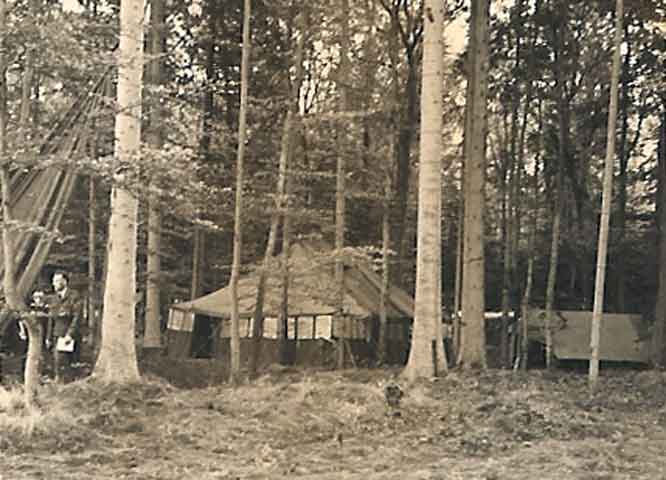
Pilots' hovel on Exercise Grand Repulse when they deployed into the woods around Jever airfield in September 1953.
(Thanks to Johnny Macknish.)
A change from this routine was when there was a Dispersal Operation in force when the ground crew and the aircrew all had to be ready at a moments notice to get the planes into the air as in a real emergency situation. The aircraft would be sited at the end of the runway in the dispersal area ready to go. The pilots sitting in the cockpits, starter generators plugged in, ground crew ready, NAAFI van due any moment, all waiting for the signal to GO! Anticipation and excitement reigned, the feeling of all pulling together was fantastic and one could imagine the supposed thrill of the real thing. All working to the same end.
At Jever we had a visit every Friday from a German salesman, a stocky chap, gold teeth and the ubiquitous small cigar, who would arrive with a variety of radios etc for sale, all offered on the never-never. He had a good selection of modern sets not yet available in the UK including their new UHF fm radios. These used the newer and smaller glass valves and had less of the 'these sets take a long time to warm up' era syndrome. He would leave chosen items with you to try, and return each Friday evening to collect the payments. Many chose to be always out when he was around the camp! He did take three of us to Wilhelmshaven in his plush VW Beetle one Saturday afternoon and dropped us off at his shop where we bought some 45 rpm records although we had nothing to play them on until we got home on leave.
With the radio and electronic knowledge that certain people had, some lads put together two or three amplifiers from modern radios, rewired them, connected the combined system to the internal Tannoy system, and one evening broadcast an emergency warning to the adjoining 4 Sqn barrack block. 'Immediately Evacuate Your Building' because of fire or some such thing. We all knew about it and gathered outside to watch the resulting mass exodus. Probably a rather stupid thing to do in hindsight but boys will be boys and we did enjoy their confusion.
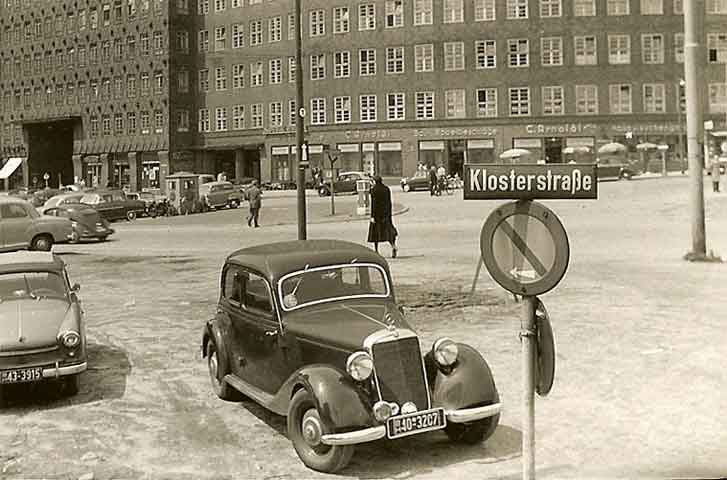
Klosterstrasse in the centre of Rinteln. Taken during a visit with the Padre. - Jul55. (Thanks to Peter Rose.)
The Padre at Jever lived in a house just outside the camp and made us very welcome. It was nice and homely to be able to listen and chat with him, and he even once arranged for us to go on a coach trip to Hamelin to see the Pied Piper. We went as a small group all wearing the well known long fawn raincoats very much in vogue at the time although we must have stood out as much had we been in uniform.
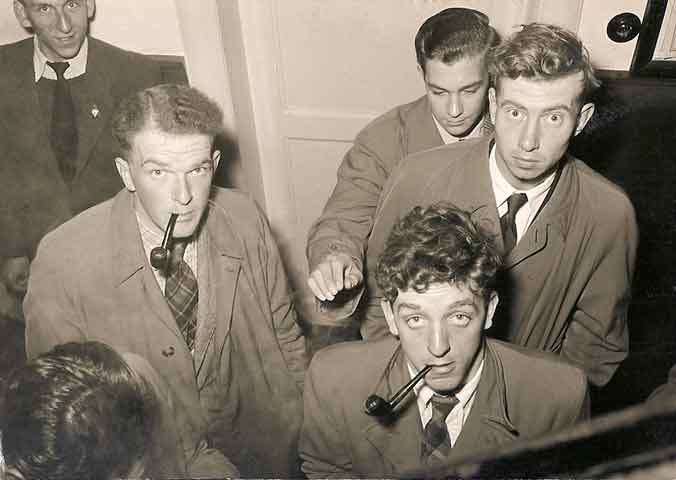
The long fawn raincoats....93 Sqn visiting the Malcolm Club at Sylt - 25May55. L to R: Guy, Neville (foreground head), Les Birch, Stan (front with pipe), Peter Rose and Buck. (Thanks to Peter Rose.)
I enjoyed my meetings with the Padre but am ashamed to say that I would not agree to read a psalm one Sunday at Church - too self-conscious I suppose. I was almost mortified when my Mother told me she had written to thank him for his interest. I do now feel that a Padre's presence at a camp such as ours was a very good thing for the ordinary airman as he was able to be almost a Father figure to us without any prejudice whatsoever in a peaceful atmosphere.
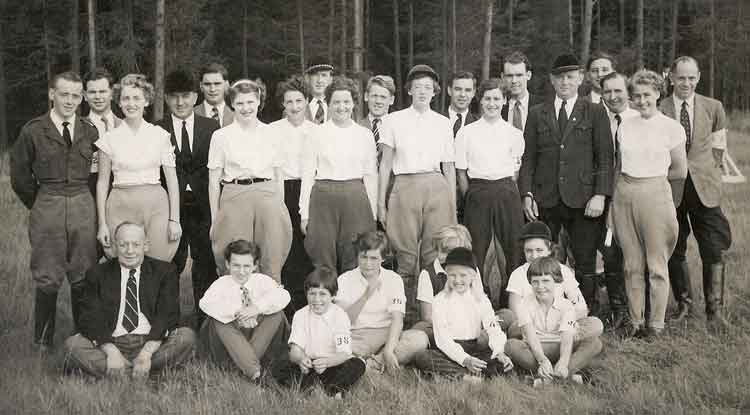
Jever Riding Club - 55. Only name known is Cpl Ginger Mitchell 4th from left in back row. (Thanks to Peter Rose.)
I had a friend in Cpl Ginger Mitchell who was a keen equestrian; a sport that had never featured in my life so far. He had all the gear, but not the horse of course, and he was a member of the Jever Riding School, a virtual classless club of men and ladies all enjoying time out with horses. Where they practised I never found out but it must have been close by.
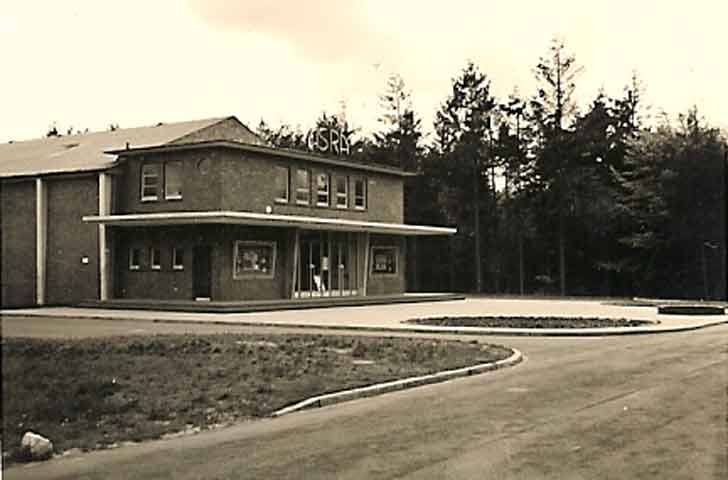
This was the first in the RAF to take a wide screen and was designed at the Airfield Construction Branch Detachment at Jever.
[Note from Mick: All RAF camp cinemas were known as the Astra, hence the translation of the RAF motto: "Per Ardua ad Astra" as "After work to the cinema"]. (Thanks Mick Ryan)
There was a cinema on the camp that showed a variety of films on a very regular basis and it was possible to go three times a week and still see a different film. I fell in love with Doris Day after seeing her latest film 'Calamity Jane' where she sang 'Secret Love', I saw this film every day it was on.
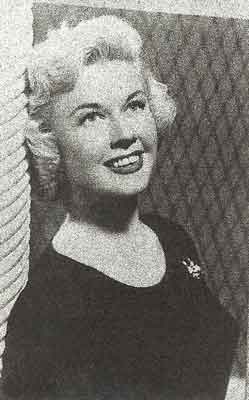
Her name escapes me!!!!
Another relaxation was with BFN, the British Forces Network, broadcast daily with requests played especially on the Sundays when Jean Metcalfe would present the programme in Germany, and Cliff Michelmore in London (they later married) - Family Favourites was indeed a popular radio treat on both sides of the North Sea.
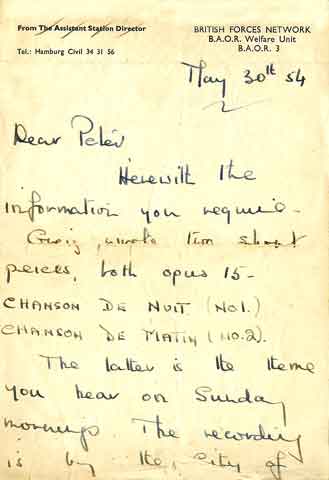
Answer from British Forces Network to Peter Rose's question about the Sunday morning signature tune - 30May54. (Thanks to Peter Rose.)
BFN would also answer by personal letter any query one had as to names of artists or musical titles. No television in those days of course so the radio broadcasts were our lifeline with home. I always loved to hear one particular favourite record regularly played - Caterina Valente singing 'The Breeze & I'. Letters, too, were always welcome with the Post Office giving the Armed Forces the standard UK rate for stamps both ways.
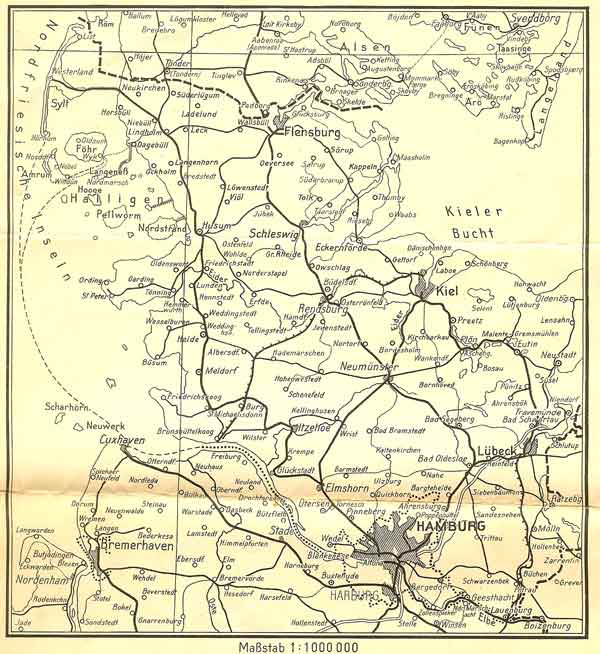
Sylt Island in relation to Schleswig-Holstein. (Thanks to Johnny Macknish.)
93 Sqn for training purposes normally travelled twice a year to Sylt, an island facing the North sea and close to the Danish border. The planes did the journey by air in next to no time but the ground crew and associate equipment went by road convoy, a much longer trip.
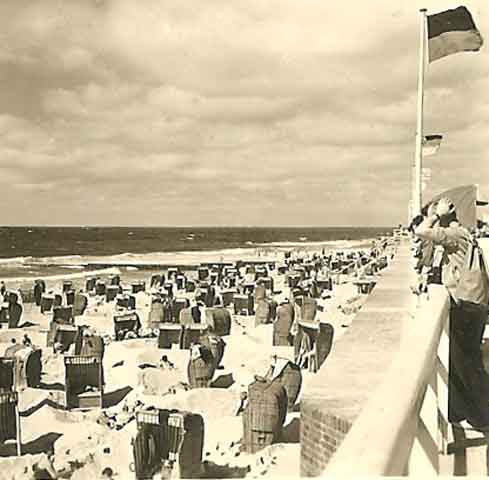
Beach just off The Promenade, Westerland, Sylt - Jul55. (Thanks to Johnny Macknish.)
It was an island paradise, a marvellous place especially in the summer when the beaches would be full of the all-encompassing wicker sun basket chairs that could be turned to suit, out of the wind, facing the sun, as you wanted. And full of mainly nudists too which certainly added a lot of value for us single airmen.
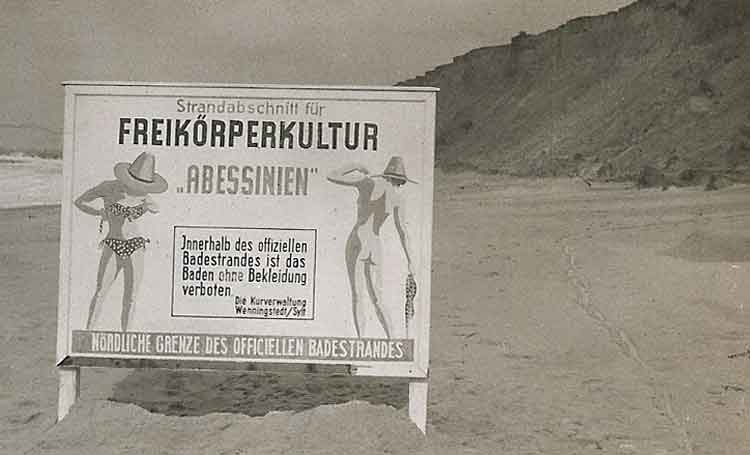
Notice warning that this section of the beach is for nudism - "Abysinnia Beach" at Sylt - May/Jun55. (Thanks to Peter Rose.)
The journey by road from Jever to Sylt took two days with an overnight stop at the transit camp in Hamburg. Here we had the chance to wander along the infamous Reeperbahn area and take in the delights which we could not afford and should not want!.
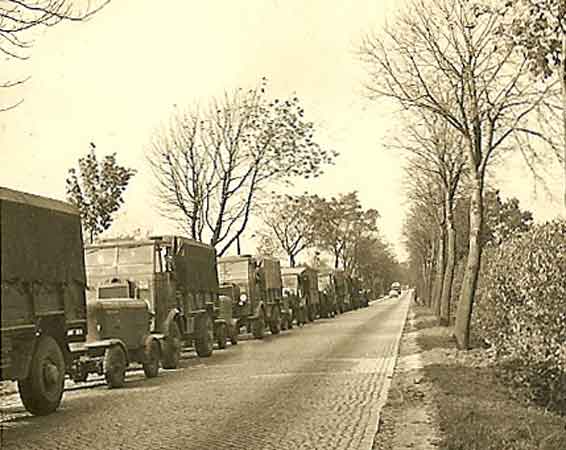
The next day we set off in convoy to Sylt going northwards towards the Danish border where the convoy would have to be driven onto a shuttle train, across the causeway, and onto the island.
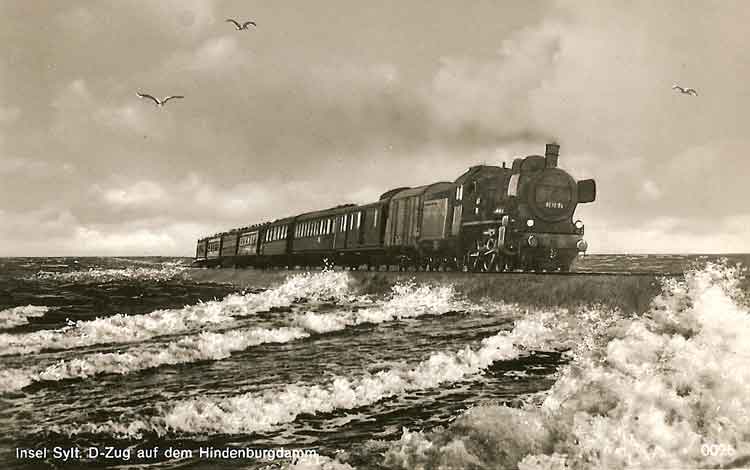
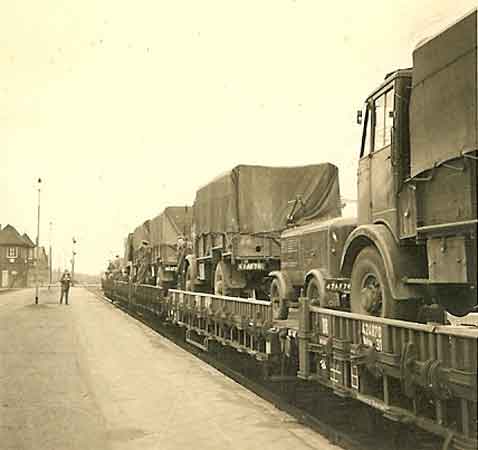
93 Sqn convoy loaded on the Niebull railway ferry presumably on the way home to Jever from Sylt - Mar55. (Thanks to Peter Rose.)
This road north was narrower than the autobahns and the somewhat faster German lorries with their multiple trailers had great difficulty in overtaking our trucks one by one - each a potentially dangerous manoeuvre.
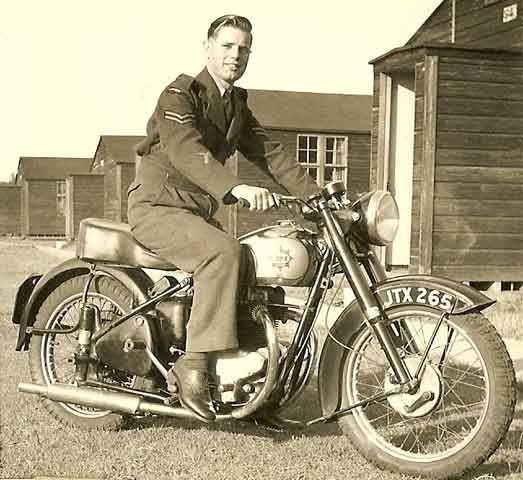
Corporal Reg Bridgeman on his motorcycle, we believe taken at Sylt because of the huts. Either he rode his bike up to Sylt or stowed it on one of the lorries - about Oct54. (Thanks to Peter Rose.)
The camp itself was laid back and very different to normal. We worked hard, and enjoyed the time off.
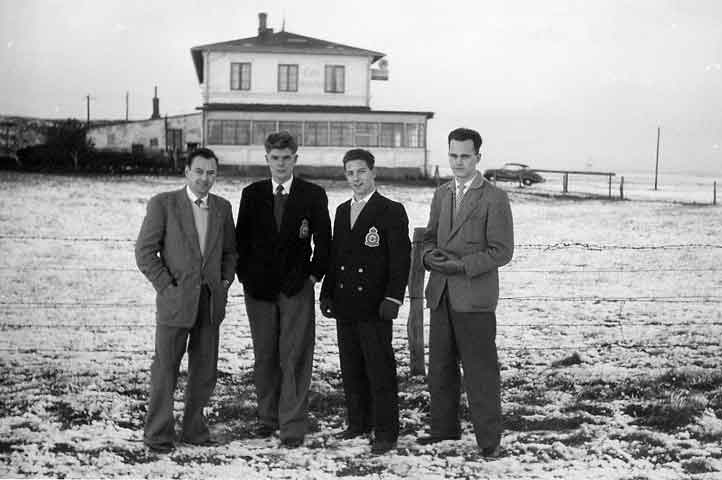
Munkmarsh Inn out of the back gate of the airfield, bordering the inland sea, Sylt - Dec57. L to R: Peter Bradbury, Ben Barron, "Framp" Frampton and Taff Parry. (Thanks to Pete Bradbury.)
The Munkmarsh was a very pleasant restaurant in the sand dunes where we could unwind, have a beer, food, and relax. There was certainly a holiday atmosphere in being stationed at RAF Sylt. The winter was different but still a pleasant change to be on the island. The sea even froze over as it was relatively shallow between island and mainland.
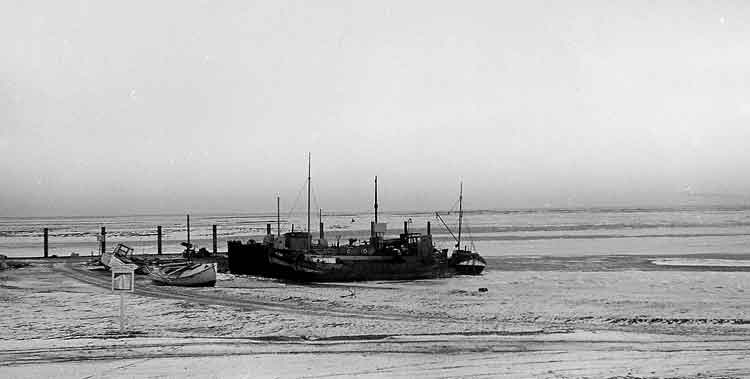
Inland Sea frozen at the back of the airfield, Munkmarsh, Sylt - Dec57. (Thanks to Pete Bradbury.)
Every airman had two three week holidays at home all paid, and a one week continental holiday. The longer UK leaves included the usual red, green or blue train as far as the Hook of Holland, the ferry over to Harwich, your fare home and the return. As other ranks we were always the last off the boat, officers, ladies, children, nco's, all before us. The last through over eager Customs, and last on the final London train. On the one occasion a small group of us chose to take our continental leave in the UK we travelled in uniform on civilian trains over there and at home, at reduced fares, and had priority treatment with the Customs at Dover who waved us through first and straight on to the London train. It was the uniforms that did the trick.
I regret not having the initiative to take the continental holiday in Germany as, for £10 (£206 in Jan09), it was possible to take all 10 days in the Hartz mountains learning to ski - all found, equipment, teaching, everything. No, I wanted to go home!
It was actually feasible to have a 10 day leave with a 48 hr pass at either end making a fortnight's holiday. This is true, as we did on our trip back to the UK mentioned earlier. In fact when we arrived back at camp they were in a 72 hour break themselves.
I finished my service at Jever in November 1955 just as the first Hawker Hunter jets were arriving (I wonder whether they had 'my' radar?) to replace the Sabres, handed in all my gear to the authorities, got numerous forms signed and tried to pack the rest of my things into manageable bags and cases. I said 'Goodbye' to my friends and with the usual train, boat, train journey ended up back at Lytham St Annes where I met old contacts from the Hednesford days, and then finally back home.
And I still had my old friend the fit-all-size sink plug! We were instructed to keep the uniform 'just in case' but I'm afraid the damp must have attacked my kit because it later just would not fit!
In hindsight, I did enjoy my time on National Service. It taught me a lot and opened my eyes to the world in general. It taught me discipline and how to look after myself and care for others too. I wish I had been wise enough to take advantage of offers made to me, to learn German while I had ample opportunity to so do (I only did French and Latin at school). Northern Germany has a history I never discovered. But that is all in the past. I had the chance and didn't take it. It makes me sad that the experience of National Service is no longer mandatory in this country albeit possibly for a shorter time. I am equally sure it would be cheaper for the government of the day to subsidize the expense of this, against the very cost of the problems that exist in today's society.
I had slight chagrin when told afterwards by the family, that they felt my 3 year National Service stint had made me from a boy into a man. In hindsight, I can now admit they might have been right! |







